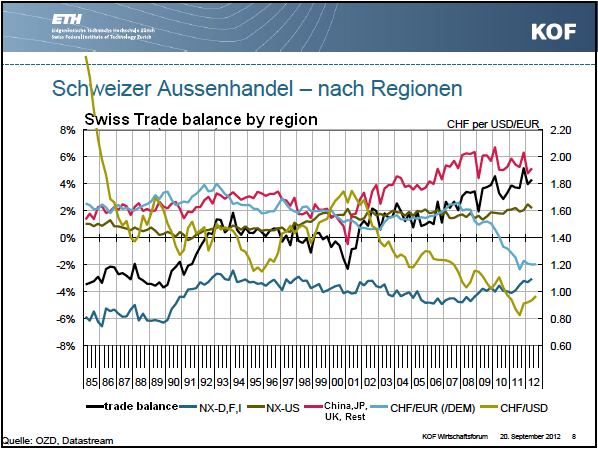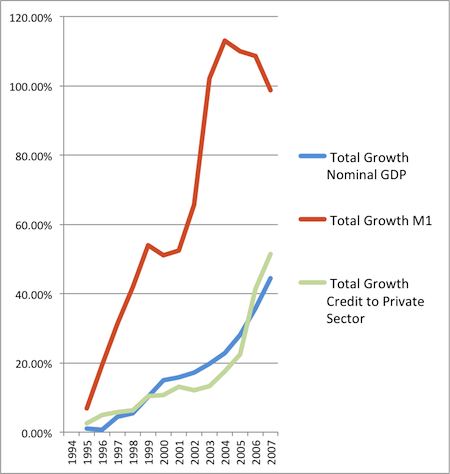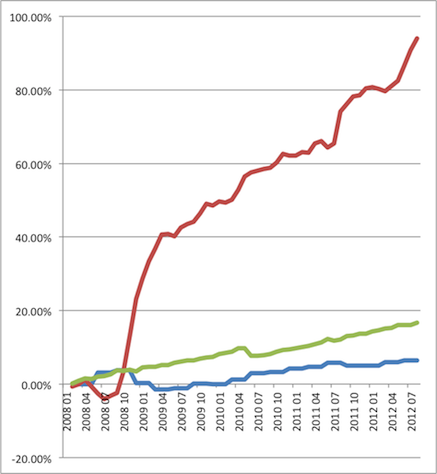Seasonal effects, the good months for the SNB and the US economy, but weaker ones for emerging markets and Switzerland
Despite the seasonal effects between October and March, the SNB is not able to sell currency reserves consistently. Traditionally the USD gets stronger and stocks rise over the autumn months till January. This year’s stocks appreciation was possibly already anticipated and/or enforced by QE3 and ECB’s OMT program.
The slowdown in trade with emerging markets, especially China (we spoke about this recently) has manifested in the third quarter trade balance, Swiss exports for China slowed by 15%.
The United States is the second most profitable Swiss trading partner; we still see an increase in exports by 17%. Since the US will expand a bit, profits of Swiss exporters to the US will be stable.
We think that sight deposits will be stable over the winter. We expect another huge increase in SNB sight deposits when the temporary effects of QE3 wane. In line with seasonal effects this will be around May 2013. In the meantime Swiss inflation will have increased sufficiently.
Recent developments
October 26
Site deposits fell by 70 million francs in the last week. Since April until the 3rd week of September they increased by a tremendous 155 billion francs. Since then they rise started slowing considerably.
SNB Monetary Data, Week Ending October 19
Week ending on October 26: 373’291 million francs (of which 79’981 “other deposits”)
Week ending on October 19: 373’360 million francs (of which 81’917 “other deposits”)
Week ending on October 12: 372’956 million francs (of which 79’814 “other deposits”)
Week ending on October 5: 372’734 million francs (of which 81’673 “other deposits”)
Week ending on September 28: 373’416 million francs (of which 82’171 “other deposits”)
Week ending on September 21: 373’731 million francs (of which 81’425 “other deposits”)
Week ending on September 14: 373’297 million francs
Week ending on September 7: 370’673 million francs
Week ending on August 31: 365’976 million francs (of which 77’017 “other deposits”)
Week ending on August 24: 362’112 million francs
Week ending on August 17: 356’676 million francs
Week ending on August 10: 353’304 million francs
Week ending on August 03: 352’055 million francs
Week ending on July 27: 341’543 million francs (of which 70’620 mil. “other deposits”)
Week ending on July 20: 331’167 million francs (of which 69’769 mil. “other deposits”)
Week ending on July 13: 320’783 million francs (of which 71’502mil. “other deposits”)
Week ending on July 13: 320’783 million francs (of which 71’502mil. “other deposits”)
Week ending on July 6: 316’901 million francs (of which 71’740 mil. “other deposits”)
Week ending on June 29: 310 970 million francs (of which 73’134 mil. “other deposits”)
Week ending on June 22: 300 894 million francs (of which 72 938 mil. “other deposits”)
This link to the SNB website gives insights into how many francs the Swiss National Bank requested commercial banks to deposit during the last week. This is just a technical accounting process: Minus (or liability) for the SNB, Plus (or asset) for the banks. Therefore it is often called “printing” like adding a zero to a currency exchange rate. The SNB uses this “printed” money to buy more currency reserves. At the same time it increases reserves from the banks at the central bank allowing them to give more loans via the money multiplier.
What does increase of money supply (or sight deposits) mean ?
The increase in sight deposits should correspond, exactly, to the same increase in FX reserves, when changes in prices are excluded: for example, 2.6 billion more money (M0 or M1 respectively) printed to buy 2.6 billion more FX reserves. The SNB has not employed swaps or repos since April 2012. Swaps or repos may distort the picture.
Is more and more “money” dangerous?
If a central bank prints more money, then domestic banks have more funds available to give loans and mortgages. As the following graphs show, credit to private borrowers rose in line with GDP between 1994 and 2007. When both growth variables grow with the same speed, then the growth is healthy. Other countries like the US, Spain, the UK or Ireland saw their credit growth rise far more quickly than GDP during that period.
The SNB printed a lot of money especially in the years before and just after the euro introduction, until 2003, to weaken the franc and the “presumed slow” Swiss growth (when measured with Taylor rates). The money increase, however, did not affect credit growth more than it should have: investors preferred other countries to Switzerland to buy assets. Finally the central bank reduced money supply between 2006 and 2008 to stop inflation.
The second graph to the right indicates that since 2009 credit growth has been growing far too quickly and beats GDP growth by more than two times.
Some say that the reason for more loans and mortgages were the bilateral agreements between Switzerland and the EU that allowed for more immigration into Switzerland. But these agreements date from 2004 and the effect would have shown up before.
(click to expand)
Difference between “deposits from domestic banks” and “Other sight deposits”
The “other deposits on sight in Swiss francs”, which the Swiss National Bank (SNB) publishes in its weekly important monetary policy data (http://www.snb.ch/en/iabout/stat/statpub/impdata/id/statpub_impdata_hist), does indeed consist of all the three following categories:
- Liabilities towards the Confederation (see explanation)
- Sight deposits of foreign banks and institutions (see explanation)
- Other sight liabilities (see explanation)
Further explanation about all four categories of sight deposits you find in the annual report 2011, p. 135 and p. 143 (http://www.snb.ch/en/mmr/reference/annrep_2011_komplett/source). In addition, in the monthly publication SNB balance sheet items, you find the most current numbers for the sight deposit categories (http://www.snb.ch/ext/stats/balsnb/pdf/deen/A1_Ausweise_der_SNB.pdf). Please note, that these numbers as well as those in the annual report are end of the month/year numbers, whereas the numbers in the important monetary policy data are weekly averages.
Kind regards
Silvia Oppliger
Deputy Head of Media Relations
Swiss National Bank
How do price changes affect money supply and FX reserves ?
When the EUR/CHF rises by 1% and deposits are increasing, then the SNB must pay more for one euro than previously. A number of 2.6 billion CHF would correspond to 1% less, namely to 2.57 billion CHF when measured with a stronger CHF. One sees that difference in price does not really matter. Moreover the dollar or yen have strongly fallen against the CHF over the “QE-unlimited” week. Therefore, the extra 0.03 billion the SNB had to pay for the euros (60% euro in the SNB portfolio) are offset maybe by 0.03 billion cheaper dollars or Yen. Last but not least, the SNB might have switched to buying the cheap dollar or Yen and selling some euros.
An example for the monetary data is shown here:
These numbers are weekly average numbers. Some editors like Thompson Reuters, here, use the most recent monthly average data, also given by the SNB, but this data is simply the data from last week.
The Limits of Money Printing
Theoretically banks could tell the SNB not to credit their accounts any more, this would prevent the SNB from printing. Still banks are sure to get the money back one day. They think that the SNB is able to get rid of all their currency reserves and to sterilize deposits. The SNB’s Dewet Moser writes in this paper how easy it was to sterilize during 2010 and 2011. However, he does not speak about the fact that the Swissie was strongly rising during this sterilization process.
Money Printing in the Euro System
Inside the euro system, ECB money printing via deposits means debiting the account of the ECB and crediting the account of the National Central Banks (NCBs) of the euro system for their participation in the ECB. This method, as used in the ELA (emergency liquidity financing), is done according to the following schema:
Eurosystem Participations

Eurosystem Participations per Country Source: ECB - Click to enlarge
30% of the ECB capital belongs to non-euro states like the UK, Sweden, Denmark, Poland or other non-euro EU member states.
Printing money means that the ECB increases its debt towards the NCBs in the ratio of the euro system participations, namely Bundesbank 27%, Banque de France 20%, Banca d’Italia 20% and Banco de Espana 12%.
If the ECB buys peripheral bonds with this money, it implies an implicit transfer from the Bundesbank and the Banque de France and other Northern states to the periphery.
The Bundesbank will refinance this money via increasing its debt at German commercial banks. These again will have more reserves which they might invest via the money multiplier to give more loans to German firms and housing. Apart from more and more debt due to Germany, this operation will increase inflation over the medium and long-term.
The ECB often employs tenders (via SMP, MTO, LTRO or OMP) to allow commercial banks to refinance her directly. In this case banks reserves at the central bank do not increase; therefore, it is also called sterilized. Since these lending banks mostly come from Germany and other Northern states, it is just another form of money transfer from the Northern states to the periphery.
Read the full details about the differences in money printing between the SNB, ECB and Fed in our article “The big Swiss Faustian Bargain” which also appeared on Zerohedge.
Are you the author? Previous post See more for Next post
Tags: ECB,M0 base money,M1,Monetary Base,monetary data,Monetary Policy,money printing,seasonal,SNB sight deposits,Swiss National Bank,Taylor Rate













































